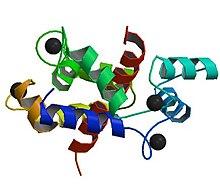
Back فرط الحرارة الخبيث Arabic Bədxassəli hipertermiya Azerbaijani Maligna hipertermija BS Hipertèrmia maligna Catalan Maligne Hyperthermie German Κακοήθης υπερθερμία Greek Hipertermia maligna Spanish هیپرترمی بدخیم Persian Maligni hypertermia Finnish Hyperthermie maligne French
| Malignant hyperthermia | |
|---|---|
| Other names | Malignant hyperpyrexia, anesthesia related hyperthermia[1] |
 | |
| Abnormalities in the ryanodine receptor 1 gene are commonly detected in people who have experienced an episode of malignant hyperthermia | |
| Specialty | Anesthesiology, critical care medicine |
| Symptoms | Muscle rigidity, high body temperature, fast heart rate[1] |
| Complications | Rhabdomyolysis, high blood potassium[1][2] |
| Causes | Volatile anesthetic agents or succinylcholine in those who are susceptible[1][3] |
| Diagnostic method | Based on symptoms and situation[2] |
| Differential diagnosis | Sepsis, anaphylaxis, serotonin syndrome, neuroleptic malignant syndrome[3] |
| Prevention | Avoiding potential triggers in those susceptible[2] |
| Treatment | Dantrolene, supportive care[4] |
| Prognosis | Risk of death: 5% (treatment), 75% (no treatment)[3] |
| Frequency | ~1 in 25,000 cases where anesthetic gases are used[1] |
Malignant hyperthermia (MH) is a type of severe reaction that occurs in response to particular medications used during general anesthesia, among those who are susceptible.[1] Symptoms include muscle rigidity, fever, and a fast heart rate.[1] Complications can include muscle breakdown and high blood potassium.[1][2] Most people who are susceptible to MH are generally unaffected when not exposed to triggering agents.[3]
Exposure to triggering agents (certain volatile anesthetic agents or succinylcholine) can lead to the development of MH in those who are susceptible.[1][3] Susceptibility can occur due to at least six genetic mutations, with the most common one being of the RYR1 gene.[1] These genetic variations are often inherited in an autosomal dominant manner.[1] The condition may also occur as a new mutation or be associated with a number of inherited muscle diseases, such as central core disease.[1][4]
In susceptible individuals, the medications induce the release of stored calcium ions within muscle cells.[1] The resulting increase in calcium concentrations within the cells cause the muscle fibers to contract.[1] This generates excessive heat and results in metabolic acidosis.[1] Diagnosis is based on symptoms in the appropriate situation.[2] Family members may be tested to see if they are susceptible by muscle biopsy or genetic testing.[4]
Treatment is with dantrolene and rapid cooling along with other supportive measures.[2][4] The avoidance of potential triggers is recommended in susceptible people.[2] The condition affects one in 5,000 to 50,000 cases where people are given anesthetic gases.[1] Males are more often affected than females.[3] The risk of death with proper treatment is about 5% while without it is around 75%.[3] While cases that appear similar to MH have been documented since the early 20th century, the condition was only formally recognized in 1960.[3]
- ^ a b c d e f g h i j k l m n o p "malignant hyperthermia". Genetics Home Reference. Jan 27, 2017. Archived from the original on 27 June 2017. Retrieved 30 June 2017.
- ^ a b c d e f g "Malignant hyperthermia" (PDF). Orpha.net. March 2013. Archived (PDF) from the original on 17 June 2013. Retrieved 30 June 2017.
- ^ a b c d e f g h Schneiderbanger, D; Johannsen, S; Roewer, N; Schuster, F (2014). "Management of malignant hyperthermia: diagnosis and treatment". Therapeutics and Clinical Risk Management. 10: 355–62. doi:10.2147/TCRM.S47632. PMC 4027921. PMID 24868161.
- ^ a b c d "Malignant hyperthermia". GARD. 30 June 2014. Archived from the original on 4 July 2017. Retrieved 30 June 2017.